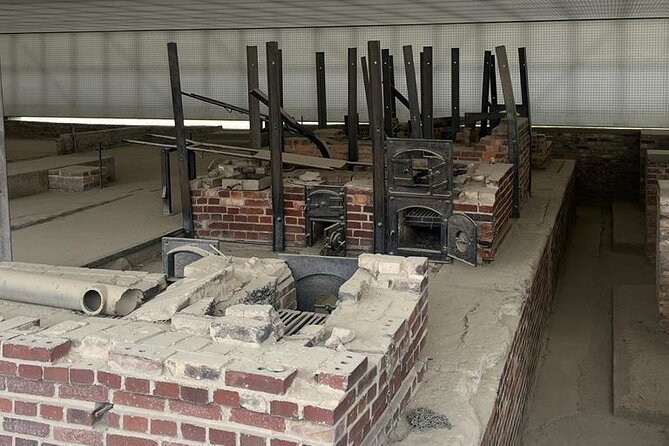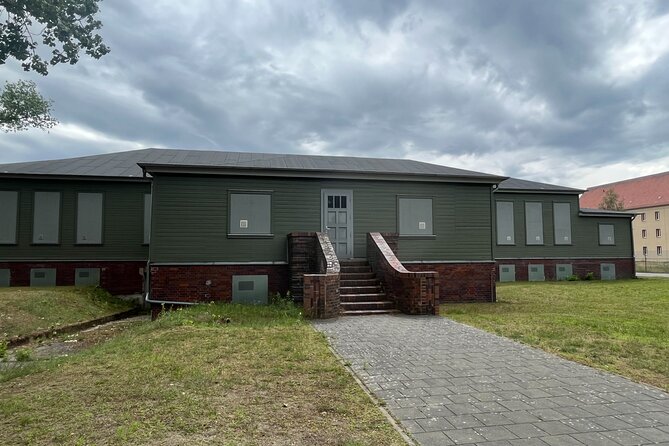The Sachsenhausen Concentration Camp, located just outside Berlin, is a sobering reminder of the horrors of the Holocaust. Established in 1936, this notorious facility housed countless political prisoners and marginalized groups, leading to immense suffering and loss of life. Today, visitors can embark on guided tours through the camp’s haunting grounds, where powerful memorials and exhibits educate them about this dark chapter in history. As they walk these grounds, they’ll be confronted with the depths of human cruelty, and the importance of remembrance and vigilance to ensure such atrocities never happen again.
Key Points
-
Sachsenhausen Concentration Camp, established in 1936, was a site of systematic persecution of Jews, Roma, and Soviet POWs, highlighting the Nazi regime’s horrors.
-
The guided tour at Sachsenhausen provides a comprehensive and progressive overview of the camp’s history, emphasizing the importance of preventing future atrocities.
-
The memorial site and exhibits at Sachsenhausen foster reflection and understanding of the victims’ experiences, serving as a reminder to honor the past and prevent repetition.
-
Visiting Sachsenhausen evokes profound emotional responses, leading to a renewed commitment to human rights and a deeper understanding of humanity’s capacity for both cruelty and compassion.
-
Preserving historical sites like Sachsenhausen and educating future generations about the Holocaust and genocides are crucial for vigilance against the resurgence of atrocities.
Historical Context

Situated in the town of Oranienburg, just north of Berlin, Sachsenhausen Concentration Camp was established by the Nazis in 1936.
Initially, it held political prisoners, but by 1939, it had become a site for the systematic persecution and murder of Jews, Roma, Soviet prisoners of war, and other groups.
The camp was also used as a training center for SS guards, who’d later be deployed to other Nazi concentration camps.
Over 200,000 prisoners passed through Sachsenhausen, and tens of thousands perished there from starvation, disease, and murder.
The camp remained operational until its liberation by Soviet forces in 1945, a chilling reminder of the horrors perpetrated by the Nazi regime.
You can also read our reviews of more tours and experiences in Berlin.
Guided Tour Through the Camp

Visitors typically begin their tour of Sachsenhausen Concentration Camp at the front entrance, where they meet their knowledgeable guide.
Armed with a mini yellow flag, the guide leads the group through the chilling grounds, providing a rundown of the camp’s harrowing history.
The tour covers key sites, including:
- The Appellplatz, where prisoners were forced to stand for lengthy roll calls.
- The hospital barracks, where horrific medical experiments were conducted.
- The execution trench, a somber reminder of the lives lost within the camp’s walls.
Throughout the experience, the guide offers a progressive, feminist perspective, educating visitors about the camp’s impact and the need to prevent such atrocities from happening again.
Powerful Memorials and Exhibits
Traversing the camp’s grounds, visitors encounter a series of powerful memorials and exhibits that poignantly commemorate the lives lost and the resilience of those who endured the horrors of Sachsenhausen. Prominent among these is the Memorial Site, featuring the National Monument, a stark concrete structure symbolizing the prisoners’ suffering. Nearby, the International Youth Meeting House serves as an educational center, while the Soviet Memorial honors the thousands of Soviet soldiers who perished in the camp. Throughout the site, interpretive displays and installations pay tribute to the victims, fostering reflection and understanding.
| Memorial/Exhibit | Key Features |
|---|---|
| National Monument | Stark concrete structure symbolizing prisoners’ suffering |
| International Youth Meeting House | Educational center |
| Soviet Memorial | Honors Soviet soldiers who perished in the camp |
| Interpretive Displays | Pay tribute to victims, foster reflection and understanding |
| Prisoner Memorials | Commemorate lives lost, resilience of those who endured |
Emotional Impact on Visitors
Stepping into Sachsenhausen’s grounds evokes a profound emotional response in visitors. The camp’s somber atmosphere and remnants of its tragic history leave a lasting impression.
Visitors often report experiencing a range of emotions, including:
- Solemn reflection on the immense suffering and loss of life that occurred at the site.
- A deep sense of empathy and compassion for the victims and their families.
- A renewed commitment to the ideals of human rights and the prevention of such atrocities.
The emotional weight of the experience can be overwhelming, but it also serves as a powerful reminder of the importance of remembering and honoring the past, in order to ensure it’s never repeated.
Reflections on Humanity’s Capacity
How does one grapple with the unspeakable horrors that unfolded within Sachsenhausen’s walls? The inhumane treatment and mass murder that occurred there represent the worst of humanity’s capacity for cruelty. Yet, paradoxically, the resilience and courage of the camp’s prisoners reveal our potential for empathy, compassion, and resistance in the face of unimaginable adversity. As visitors reflect on this dichotomy, they are confronted with the sobering reality that the human condition encompasses both the darkest and brightest impulses. The following table examines this dynamic more closely:
| Darkness | Light |
|---|---|
| Dehumanization | Dignity |
| Indifference | Solidarity |
| Totalitarianism | Dissent |
| Annihilation | Survival |
Importance of Remembrance and Vigilance
The solemn duty to remember the horrors of Sachsenhausen concentration camp underscores the vital importance of vigilance against the resurgence of such atrocities.
Remembering the past serves as a powerful safeguard against the repetition of horrific human rights violations. To uphold this imperative, three key actions are crucial:
- Educating current and future generations about the realities of the Holocaust and other genocides.
- Advocating for the preservation of historical sites and artifacts that bear witness to these tragedies.
- Actively denouncing and combating all forms of extremism, intolerance, and discrimination that threaten human dignity.
Only through unwavering commitment to these principles can we truly honor the memory of those who perished and ensure that such devastation is never again inflicted upon humanity.
Practical Information for Visitors
Visiting the Sachsenhausen Concentration Camp memorial site requires thoughtful planning to ensure a meaningful and respectful experience.
The tour starts at €25 per person, with a lowest price guarantee and free cancellation up to 24 hours in advance. Travelers can reserve now and pay later for flexibility.
The experience lasts approximately 4 hours and departs from the front of Espresso House, where a guide with a mini yellow flag will identify themselves. The tour returns to the original meeting point.
Advance ABC ticket purchase is required, and visitors should check availability before booking.
The experience isn’t wheelchair accessible, but service animals are permitted. A moderate fitness level is needed, with a maximum group size of 15 travelers.
Sum Up

The Sachsenhausen Concentration Camp stands as a haunting reminder of the unspeakable cruelty mankind is capable of. Yet, its memorials and exhibits also inspire hope, demonstrating the resilience of the human spirit. As one visitor remarked, "The horrors of the past must never be forgotten, lest we risk repeating them." This solemn message underscores the vital importance of honoring the victims and safeguarding against future atrocities.
More Tour Reviews in Berlin
- Evening Boat Tour 1.5 hour with our solarcatamaran
- Self-drive E-Scooter shared guide in small groups
- Berlin: History of the Third Reich Guided Walking Tour
- Private Berlin Rickshaw- Historical Berlin Up to 6 People
- Graffiti Workshop In Mecca Of Graffiti – Berlín
- Private Rickshaw Berlin Highlights and secrets up-to 6 Pers.
Not for you? Here's more nearby things to do in Berlin we have reviewed
- Evening Boat Tour 1.5 hour with our solarcatamaran
- Self-drive E-Scooter shared guide in small groups
- Berlin: History of the Third Reich Guided Walking Tour
- Private Berlin Rickshaw- Historical Berlin Up to 6 People
- Graffiti Workshop In Mecca Of Graffiti – Berlín
- Private Rickshaw Berlin Highlights and secrets up-to 6 Pers.
- Creative Portraits in Berlins Streets
- Potsdam: Original steam ship Gustav from 1908. Coal-fired, boat tour
- Red Berlin: Secrets of the Communist Capital
- Private Rickshaw Taylor Made By Night Tour
- Potsdam & Sanssouci Gardens Private Tour With Jacob
- Quatsch Comedy Club Berlin: Die Live Show Entry Ticket
